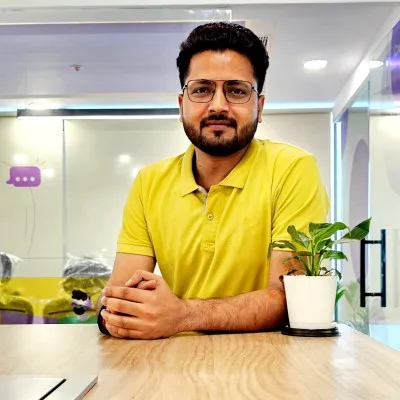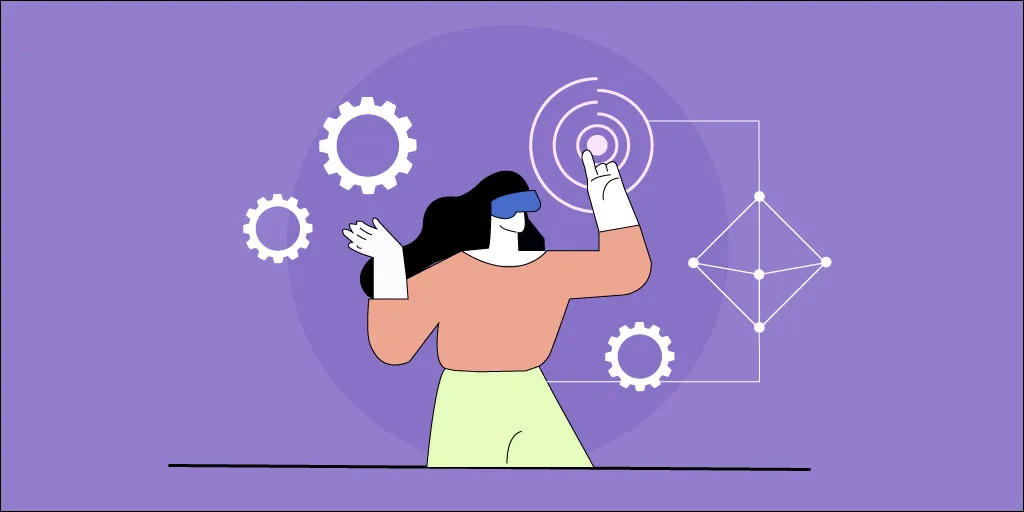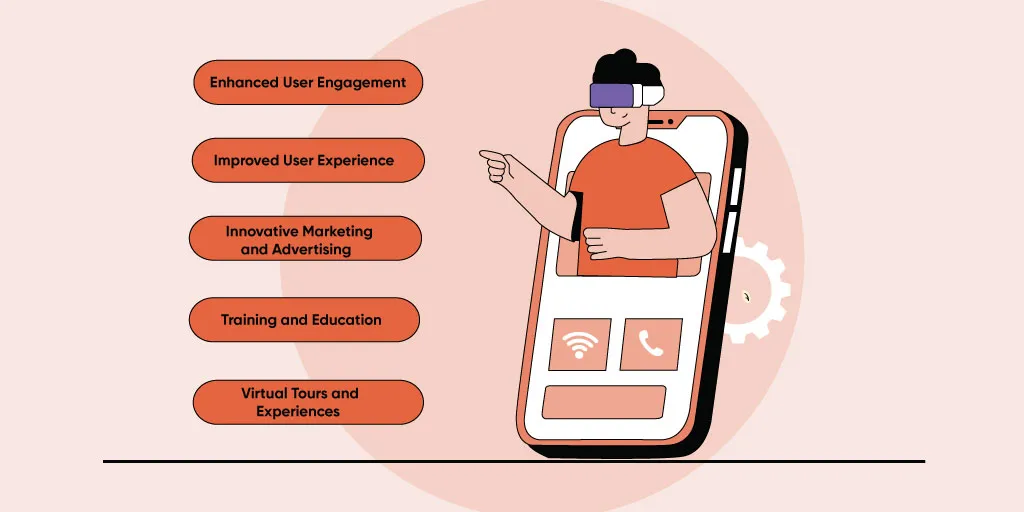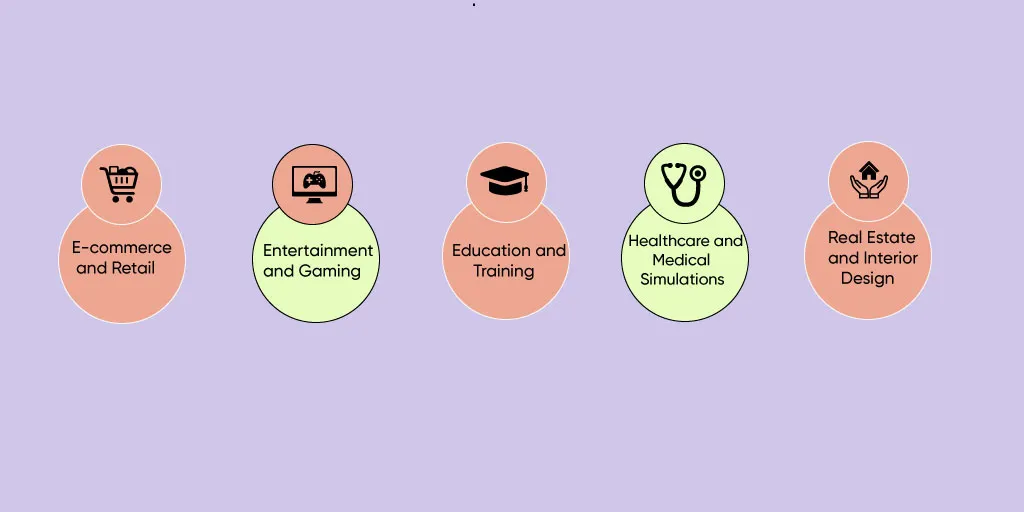Technology


7 min


VR and AR app development is at the forefront of technological innovation, offering endless possibilities across various sectors. As these technologies continue gaining momentum, skilled developers' role in shaping our digital future becomes increasingly significant. This blog provides an insightful overview of VR and AR app development, shedding light on the key concepts, trends, and possibilities in this exciting realm.

By Anupam Singh
27 Oct, 2023
Hey there, tech enthusiasts and curious minds! Are you ready to dig into the exciting era of Virtual Reality (VR) and Augmented Reality app development? If you've ever wondered what it takes to create mind-bending, immersive experiences that blur the lines between the digital and physical worlds, you're in for a treat.
In this blog, we're diving deep into VR and AR app development's captivating universe, unravelling the mysteries and uncovering the possibilities. So, grab your headsets, open your minds, and analyse how these cutting-edge technologies reshape our digital ecosystem.
 Augmented Reality (AR) and Virtual Reality (VR) are advanced technologies that provide immersive and interactive experiences to users.
Augmented Reality (AR) and Virtual Reality (VR) are advanced technologies that provide immersive and interactive experiences to users.
Augmented Reality (AR) overlays virtual elements onto the real-world environment, enhancing it with additional digital information. AR integrates computer-generated graphics, sound, and other sensory inputs into the user's real-world perception. It enables users to interact with virtual objects while maintaining a connection with the physical environment. AR is commonly experienced through mobile devices, smart glasses, or heads-up displays.
Virtual Reality (VR) creates a simulated digital environment that completely immerses users, blocking the real world. VR app development typically involves wearing a head-mounted display (HMD) that covers the eyes and sometimes incorporates motion-tracking devices or controllers for interaction. Users feel as though they are physically present in the virtual world, allowing them to explore and interact with virtual objects and environments in a highly immersive manner. VR finds applications in gaming, training simulations, virtual tours, therapy, and entertainment experiences.
AR and VR development technologies can transform healthcare, education, architecture, entertainment, and industries by offering unique and engaging experiences beyond traditional media formats. They open up new communication, visualization, and interaction possibilities. Nevertheless, enables users to discover and interact with digital content in innovative & captivating ways.
| Augmented Reality | Virtual Reality |
|---|---|
| Pokémon Go: The popular mobile game lets players capture virtual Pokémon creatures in real-world locations using their smartphone's camera and AR technology. | VR Gaming: VR gaming provides an immersive gaming experience where players can explore virtual worlds, interact with objects, and engage in realistic gameplay using specialized VR headsets and controllers. |
| Snapchat Filters: Snapchat's filters utilize AR to add virtual elements, such as masks, animations, or effects, to users' faces in real-time while capturing photos or videos. | Virtual Tours: VR technology enables virtual tours of real-world locations, historical sites, museums, or properties, allowing users to virtually explore and experience these places as if they were physically present. |
| AR Navigation: AR-powered navigation apps, like Google Maps AR, provide real-time visual cues and directions overlaid in the real world, making it easier for users to navigate unfamiliar places. | VR Training Simulations: Industries such as healthcare, aviation, and the military use VR simulations for training. These simulations create realistic scenarios where individuals can practice skills, decision-making, and critical tasks in a safe and controlled virtual environment |
The AR & VR market is experiencing remarkable growth, with revenue projected to reach an impressive US$32.1 billion in 2024. This upward trend is expected to continue, with an estimated annual growth rate (CAGR 2023-2027) of 13.72%. By 2027, the market volume is anticipated to expand even further, reaching a projected value of US$53 billion.
Among the various segments, AR Software stands out as the largest market, with a substantial market volume of US$11.58 billion forecasted for 2024. Additionally, the United States is the leading revenue generator in the AR & VR market, with a projected market volume of US$8,568.00 million in 2024.
As for user adoption, the number of AR & VR users is projected to rise significantly, reaching approximately 2,593.00 million users by 2027. This growing user base highlights AR and VR technologies' increasing popularity and widespread acceptance in the coming years.
 AR and VR technologies significantly enhance mobile app development services by offering immersive and interactive experiences to users. Here's how AR and VR contribute to AR app development:
AR and VR technologies significantly enhance mobile app development services by offering immersive and interactive experiences to users. Here's how AR and VR contribute to AR app development:
(1.) Enhanced User Engagement
AR and VR provide unique and captivating experiences that can significantly enhance user engagement within mobile apps. By incorporating AR and VR elements, developers can create interactive features, such as 3D models, animations, or virtual environments, that immerse users and keep them engaged for longer durations.
(2.) Improved User Experience
AR and VR technologies allow developers to create intuitive, user-friendly interfaces. By leveraging these technologies, mobile apps can offer more intuitive ways of interacting with content, such as gesture-based controls, spatial recognition, or voice commands, resulting in a seamless and immersive user experience.
(3.) Innovative Marketing and Advertising
AR and VR can revolutionize marketing and advertising strategies within mobile apps. With Augmented Reality app development, apps can offer virtual try-on experiences for products like clothing or cosmetics, allowing users to visualize how they would look before making a purchase. VR can transport users to virtual showrooms, events, or brand experiences, creating impactful and memorable marketing campaigns.
(4.) Training and Education
AR and VR have immense potential in the field of training and education. Mobile apps can leverage these technologies to provide immersive simulations, virtual classrooms, or interactive learning experiences. For example, medical training apps can use AR to simulate surgical procedures, while language learning apps can use VR to transport users to virtual language immersion environments.
(5.) Virtual Tours and Experiences
AR and VR enable mobile apps to offer virtual tours of real-world locations, museums, historical sites, or architectural spaces. Users can explore and interact with these environments from the comfort of their mobile devices, providing a rich and informative experience.
(6.) Gamification and Entertainment
AR and VR can bring gaming and entertainment experiences to the next level within mobile apps. Developers can create immersive and interactive games or entertainment apps that blur the lines between the real and virtual worlds, providing users with exciting and memorable experiences.
 The versatility of AR and VR technologies makes them applicable to various industries and use cases. Some prominent examples include:
The versatility of AR and VR technologies makes them applicable to various industries and use cases. Some prominent examples include:
However, if you want to dig more into Trends and Use Cases of AR/VR in Mobile app development, we have got you covered.
AR app development can transform the shopping experience by allowing users to try on clothes virtually, visualize furniture in their homes, or see how makeup products look on their faces. Conversely, VR can create virtual stores or showrooms where users can explore and interact with products realistically.
AR and VR have revolutionized the gaming industry by enabling immersive gameplay experiences. Mobile games can now be overlaid onto the real world (AR) or transport players to virtual realms (VR), providing thrilling and captivating adventures.
AR and VR have immense potential in education and training. Students can visualize complex concepts more engagingly, while professionals can undergo realistic simulations for training. From anatomy lessons to flight simulations, AR and VR bring learning to life.
AR and VR find applications in medical training, surgical simulations, and patient care. Surgeons can practice complex procedures in a risk-free virtual environment, while patients can benefit from interactive visualizations of their conditions.
AR and Virtual Reality app development enable users to virtually walk through properties, visualize renovations, and experiment with designs. These technologies help real estate agents and interior designers showcase their offerings and give clients an immersive preview.
To develop AR and VR Android/iOS apps, developers need to consider various technical aspects, including:
AR and VR Technologies and Platforms
Several AR and VR app development platforms are available, such as Apple's ARKit, Google's ARCore, and Unity3D. These platforms provide the necessary tools and frameworks to build immersive experiences for mobile devices.
Hardware Requirements for AR and VR Apps
AR apps typically require devices with built-in cameras and sensors to track the real world. VR apps, on the other hand, often rely on headsets that provide a fully immersive experience. Developers must optimize their apps for compatibility with different hardware configurations.
Programming Languages and Frameworks
Common programming languages for AR and VR app development include C#, Java, and JavaScript. Frameworks like Unity3D, Unreal Engine, and Vuforia simplify the development process by providing pre-built components and libraries.
While AR and VR hold immense potential, they also present specific challenges and limitations:
AR and VR experiences heavily depend on mobile devices' hardware capabilities. Older or low-end devices may not offer optimal performance or compatibility with advanced AR and VR features, limiting the target audience.
Building AR and VR apps requires specialized skills and knowledge. Developers need to understand the technical aspects of AR and VR and the principles of user experience design to create compelling and seamless applications.
Although AR and VR are gaining popularity, users are still learning to familiarize themselves with these technologies. It may take time for mainstream adoption and widespread AR and VR mobile app usage.
AR and VR apps often require user data and environment access. Developers must prioritize privacy and security measures to protect user information and ensure a safe and trustworthy experience.
 The future of AR and VR in mobile app development holds exciting possibilities:
The future of AR and VR in mobile app development holds exciting possibilities:
(1.) Integration with Artificial Intelligence (AI)
Combining AR, VR, and AI can create more immersive and intelligent experiences. AI algorithms can enhance object recognition, enable natural language processing, and personalize content based on user preferences.
(2.) Advancements in Wearable Devices
As wearable devices become more sophisticated, they offer enhanced AR and VR experiences. Smart glasses and haptic gloves can provide users with seamless and immersive interactions in the natural and virtual worlds.
(3.) Enterprise Applications
AR and VR are increasing adoption in enterprise applications, enabling remote collaboration, virtual meetings, and training simulations. These technologies have the potential to revolutionize workflows and enhance productivity.
(4.) Social and Collaborative Experiences
AR and VR are evolving beyond solitary experiences. Social and collaborative features allow users to connect with others in virtual spaces, fostering new forms of communication, gaming, and shared experiences.
In conclusion, augmented reality (AR) and virtual reality app development have transformed these digital & innovative landscapes. These immersive technologies offer enhanced user experiences, increased engagement, and real-world integration across various industries. While challenges exist, the future holds promising advancements and widespread adoption of AR and VR in mobile apps.
What is the difference between augmented reality and virtual reality
Augmented reality (AR) overlays digital information in the real world, enhancing the user's perception of reality. Virtual reality (VR) creates a fully immersive experience, transporting users to a virtual environment separate from the real world.
Can AR and VR be used in mobile gaming?
Yes, AR and VR have revolutionized the gaming industry. Mobile games can leverage AR to overlay virtual elements onto the real world, providing interactive experiences. VR takes gaming to a new level by immersing players in virtual environments.
Are there any privacy concerns with AR and VR apps?
AR and VR apps often require access to users' data and environments. Privacy concerns include:
What programming languages are commonly used for AR and VR app development?
Commonly used programming languages for AR and VR app development include C#, Java, and JavaScript. These languages are supported by development frameworks such as Unity3D and Unreal Engine, making it easier to create immersive experiences.
How can AR and VR enhance the e-commerce experience?
AR and VR can revolutionize the e-commerce experience by allowing users to visualize products in their real-world environment. Users can virtually try on clothes, preview furniture in their homes, or see how makeup products look on their faces, providing a more immersive and informed shopping experience.
What Is an API? A Developer's Guide to Application Integration in 2025
By Dhruv Joshi
5 min read
What Is a Push Notification and Why It Matters for Your App Strategy
By Dhruv Joshi
5 min read
Top React Native Development Companies to Build Scalable Apps
By Dhruv Joshi
5 min read
How Wearable Technology Is Driving Real-Time Data Experiences in Mobile Apps
By Sannidhya Sharma
5 min read

Technology


5 min
What is an API? Learn the real meaning of Application Programming Interfaces in 2025, how APIs work, why they're essential to software development, and how to integrate them. This developer-focused guide breaks down API types, use cases, benefits, and best practices for business success.


Technology


5 min
Wearable technology is reshaping mobile apps with real-time insights, enabling smart alerts, fitness coaching, health monitoring, and more. From smart rings to AR glasses, explore how these evolving devices are creating seamless, personalized experiences across various industries and everyday life.


Technology


5 min
Augmented reality in retail helps brands drive sales and reduce returns by transforming how customers discover, try, and buy products. This blog is your guide to using AR strategically, from choosing the right use cases to launching cost-effective AR experiences that delight customers and differentiate your brand.


Feeling lost!! Book a slot and get answers to all your industry-relevant doubts